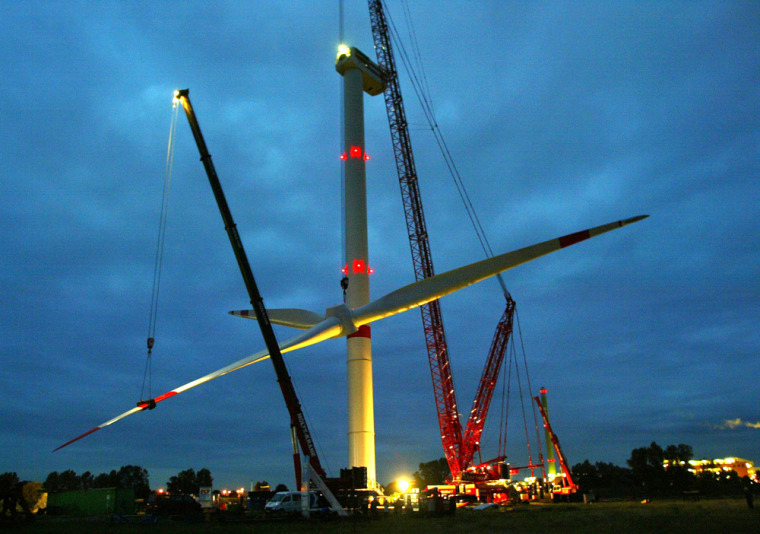In this north German town a huge crane is helping to build the world’s largest wind power plant, a prototype for offshore wind farms expected to be operating in 2006.
Just across a meadow of grazing cows sits another source of energy, one generation older and a symbol of a different political ideology.
Built in the 1970s, the Brunsbuettel nuclear power station is still part of the backbone of German energy production, but will soon reach the end of its life cycle because of Germany’s drive to phase out nuclear energy.
“I think it’s a really charming scene,” said Fritz Vahrenholt, chairman of Germany’s Repower, the company producing the wind turbine. “Nuclear reactor meets wind plant. Here the future and over there the past and none of them produces carbon dioxide,” a so-called greenhouse gas that many scientists fear is warming the Earth.
Debating energy
The construction of Repower’s $17 million turbine comes as Germany is caught in a controversial debate over the reasons for the country’s rising energy prices, in which the subsidized wind power industry plays its part.
Consumer groups say Germany’s four leading utilities, including RWE and Vattenfall Europe, were abusing their power in a market which lacks competition and a state regulator.
The industry, on the other hand, says price hikes were necessary, partly because of politically induced costs for green energy such as wind power which would force it to spend billions of euros on grids linking offshore wind farms with the mainland.
Some electricity consumers are echoing that criticism, saying they are tired of supporting green energy production by way of their power bill and of the “giant asparagus” on the horizon.
Impressive sight
Repower expects sightseers, not protesters, to arrive at Brunsbuettel and has put up a sausage stand to cater for them.
“We have had calls from fan clubs keen to know more about our turbine and the giant crane on the site,” said Martin Skiba, who is responsible for Repower’s “5M” prototype project.
Repower’s workers are installing three blades. Each of the 200-long blades weighs 18 tons — or the equivalent of a dozen average passenger cars.
The tower will be 600 feet high when measured from the base to the tip of a rotor blade, almost twice the height of New York’s Statue of Liberty.
Once Repower’s flagship starts rotating, it is expected to produce 17 gigawatt hours of electricity a year at the Brunsbuettel site, enough to power 4,500 average households.
This is much more than other wind turbines, but very little compared to its 806 MW strong nuclear neighbor, which generates around 6,000 GWh per year.
What to do with nuclear?
One question therefore remains: Will wind power be able to compensate Germany’s lost capacity as nuclear plants are phased out and other aging plants closed?
Germany must replace nearly half of its 100,000 MW generation capacity in the next two decades and critics say renewables will never be able to fill that gap.
Wind power, they add, is too reliant on weather conditions.
“Wind power can only complement other energy sources. It cannot replace them,” Vahrenholt said. “I am sure there will be a revival of coal-fired energy production with new technologies such as the isolation of carbon dioxide during the generation process.”
Germany, which depends on nuclear power for a third of its electricity, still has no clear plan on how to replace reactors such as the one in Brunsbuettel.
“That’s why it’s foolish to shut the reactors so soon," Vahrenholt said. "It would overstrain the German economy. We need more time and have to extend the running times for nuclear plants by 5-7 years.”
Whether Vahrenholt’s view is shared by others in the industry and future governments is hard to predict.
But if he turns out to be right, Brunsbuettel’s wind and nuclear power plants might be neighbors for longer than expected.
